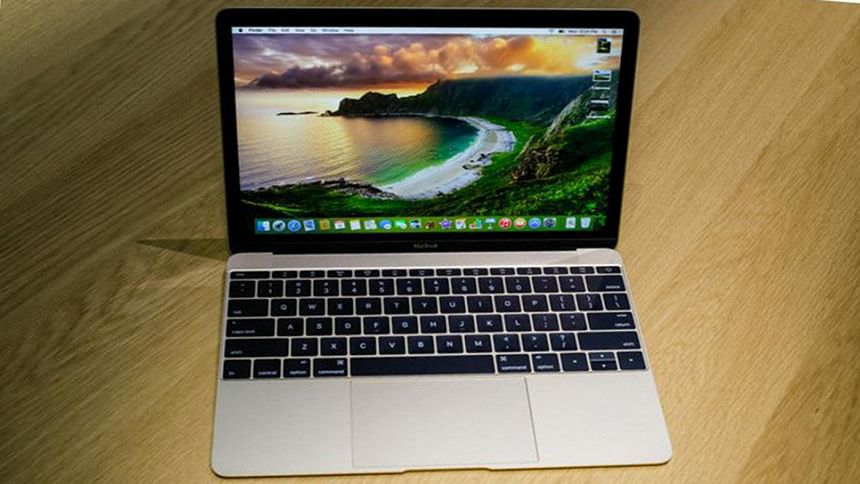Apple's thinnest MacBook ever

It has long been on the list of most-rumored new Apple products, and now we have a new MacBook.
This is the thinnest Mac that Apple has ever made: at its thickest point it is just 13.1mm (about half an inch), 24 percent thinner than the existing 11-inch MacBook Air. It is also the lightest at 2 pounds (0.9 kg).
Making the laptop this thin required complete redesigns of just about every component, including the keyboard, trackpad and battery.
The keyboard, for example, uses a new butterfly mechanism for keys. It uses a single assembly that is four times more stable than a traditional scissor mechanism, while being 40 percent thinner. Apple says the keyboard is shallower, but with a larger face for each key. The backlight has a light for each key, which is nice -- backlit keyboards sometimes blow the user out in low light.
The new trackpad no longer has a top hinge to physically click down. Instead the user will be tapping on the pad, which uses four Force Touch sensors that sense a range of pressure from the lightest click to a deeper press that Apple calls Force Click.
Instead of the mechanical click of past trackpads, the user will just get the feel of a click through haptic feedback. The lack of downward motion allowed Apple to shave space off the design. This seems to make the capacitive glass surface behave more like a touchscreen, too, expanding what the trackpad can be used for.
Another change that went into making the laptop thinner and lighter is that the new MacBook is the first Apple laptop to go fanless. That is something we started to see in 2014 in Windows laptops using Intel's Core M processors, and that is what this laptop is using, too.
Battery life with the Core M processors has not been great, so Apple said that in order to solve the Core M "known issue," the MacBook is pretty much all battery on the inside. While ultraportables usually use a single thin sheet battery, Apple decided to cut the battery into multiple sheets that can be terraced with contoured shapes. Apple says the MacBook will get up to 9 hours of wireless Web use or 10 hours of iTunes video playback.
There is but one single port on the system, type USB-C, that will support -- through dongles, likely -- everything from power to Ethernet to HDMI. The only other connector the user will find is a headphone/mic jack.
Lastly, the new MacBook has a 12-inch Retina Display with a 2,304x1,440-pixel resolution. It, too, has a new design -- it is the thinnest ever built into a MacBook, at 0.88mm -- with a larger aperture for light and individual pixels in red, green and blue.
The starting configuration of the new MacBook will include a 1.1GHz Intel Core M, 8GB of RAM and a 256GB solid-state drive (SSD) for $1,299 and ships beginning April 10. An upgraded version will be available for $1,599 with a 1.2GHz Core M, 8GB of memory and 512GB of flash storage. Both use integrated Intel HD Graphics 5300.
In the UK and Australia, the prices start at £1,049 and AU$1,799 for the base model and hit £1,299 and AU$2,199 for the upgrade.
Hands on with the new keyboard and trackpad
All those spec and feature changes can be dizzying, and does not really explain how the new design works on a practical level.
Having had an opportunity to play around with the new MacBook in a couple of different settings following Apple's March 9 event, it is immediately familiar, but with a few radical shifts.
The first major change is to the keyboard. The nearly edge-to-edge keyboard has larger key faces, yes, but the keys are also shallower, barely popping up above the keyboard tray and depressing into the chassis only slightly. It takes some getting used to, especially if the user is accustomed to the firm, clicky physical feedback of the current MacBooks, or the similar island-style keyboards of most other modern laptops.
The four sensors previously mentioned allow the user to click anywhere on the pad's surface with identical results, and the Force Click effect, which combines the sensors with haptic (or taptic) feedback, allow the user to have two levels of perceived clicking within an app or task. That deep click feels to the finger and brain like the trackpad has a stepped physical mechanism, but in fact, the movement the user feel is a small horizontal shift, which, even when fully explained, feels like the user is depressing the trackpad two levels.
Apple describes it like this: "With the Force Touch trackpad, force sensors detect your click anywhere on the surface and move the trackpad laterally toward the user, although the feel is the same familiar downward motion you're accustomed to in a trackpad."
The most advanced use of the trackpad Apple showed off was fast-forwarding through a video clip in Quicktime, faster or slower, depending on how hard the user pressed down on the trackpad.
In my hands-on time, some of the functions felt very natural, others will take some getting used to, but the idea has a lot of potential if Apple incorporates it into all of its apps, and if third-party software companies also find creative ways to adopt it.
Goodbye to ports
One thing that will throw a lot of people is the new approach to ports and connections. This MacBook is radically stripped down to only two ports. A USB-C port that acts as a power and general accessory connection, and a standard one-eighth-inch audio combo headphone/mic jack, similar to the one found on current MacBooks.
For power, there is a long USB-C cable, which has a connector that is both smaller than the current USB-A design, and also works with either side facing up (the user could call it an ambidextrous connector). That plugs into a standard power brick, which looks and feels a lot like the ones that come with iPads, except they have a USB-C connection, rather than a USB-A connection.
More complex ones were small connection blocks, combining a VGA or HDMI video output with one USB-A port, as well as one USB-C port, which would allow the user to provide power to the laptop at the same time. That multiport adapter will set the user back $79, £65 or AU$119.
If the user think back to the original MacBook Air, released in 2008, it also had a single-port design, with one USB 2.0 port. Over time, more ports, from HDMI to Thunderbolt to an SD card slot, were added.
Performance, battery life and other unanswered questions
More so than the changes in user input tools and screen size, the value of the new MacBook will be determined by its performance and battery life. The Core M CPU from Intel has great potential, but also has yet to impress in the tests those have been done with it in other systems.
Outside of that, this new system includes nearly everything Mac watchers had on their wish lists, from a smaller, higher-resolution screen to a new keyboard and trackpad to a thinner, lighter body.

 For all latest news, follow The Daily Star's Google News channel.
For all latest news, follow The Daily Star's Google News channel. 



Comments